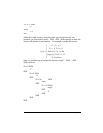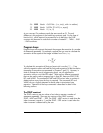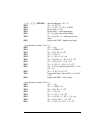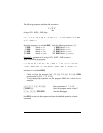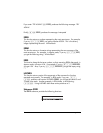
Page 21-58
3 @@@S1@@ Result: S:14 4 @@@S1@@ Result: S:30
5 @@@S1@@ Result: S:55 8 @@@S1@@ Result: S:204
10 @@@S1@@ Result: S:385 20 @@@S1@@ Result: S:2870
30 @@@S1@@ Result: S:9455 100 @@@S1@@ Result: S:338350
The START…STEP construct
The general form of this statement is:
start_value end_value START program_statements increment
NEXT
The start_value, end_value, and increment of the loop index can be positive
or negative quantities. For increment > 0, execution occurs as long as the
index is less than or equal to end_value. For increment < 0, execution
occurs as long as the index is greater than or equal to end_value.
Example – generating a list of values
Suppose that you want to generate a list of values of x from x = 0.5 to x = 6.5
in increments of 0.5. You can write the following program:
« → xs xe dx « xs DUP xe START DUP dx + dx STEP DROP xe xs
– dx / ABS 1 + →LIST » »
and store it in variable @GLIST.
In this program , xs = starting value of the loop, xe = ending value of the loop,
dx = increment value for loop. The program places values of xs, xs+dx,
xs+2⋅dx, xs+3⋅dx, … in the stack. Then, it calculates the number of elements
generated using the piece of code: xe xs – dx / ABS 1. +
Finally, the program puts together a list with the elements placed in the stack.
Θ Check out that the program call 0.5 ` 2.5 ` 0.5 ` @GLIST
produces the list {0.5 1. 1.5 2. 2.5}.
Θ To see step-by-step operation use the program DBUG for a short list, for
example:



